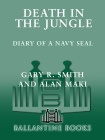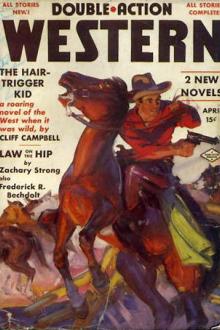Death in the Jungle by Gary Smith (most inspirational books .txt) 📕

Read free book «Death in the Jungle by Gary Smith (most inspirational books .txt) 📕» - read online or download for free at americanlibrarybooks.com
- Author: Gary Smith
Read book online «Death in the Jungle by Gary Smith (most inspirational books .txt) 📕». Author - Gary Smith
Lay: The direction of the twist of strands of a rope.
LCPL MK4 and LCPL MK 11: The Landing Craft, Personnel, Launch. The MK 11 had a lower free board and more stowage area than the MK 4. However the MK 11 was not adapted for lifting by whelin davits, and the hull would not fit in standard shipboard skids. The hull of the MK 11 was constructed of laminated fiberglass and plastic, and was easily maintained. The MK 11 was 36 feet in length, with a draft of 3 feet, 11 inches. It was powered by one 300-horsepower Gray marine diesel engine, with a top speed of 17 nautical miles per hour, and a maximum range of 173 nautical miles.
Leave: Authorized absence in excess of 48 hours.
Lee: Direction away from the wind.
Leeward: In a lee direction. Pronounced “lu’ard.”
Liberty: Authorized absence of less than 48 hours. More accurately, a sailor’s favorite time of the day.
Libsville: Same as liberty.
Line: Seagoing term for rope; also, the equator.
Lookout: Seaman assigned duties involving watching and reporting to the Officer of the Deck (OOD) any objects of interest; the lookouts are “the eyes of the ship.”
Loran (long range navigation): A navigational system that fixes the position of a ship by measuring the difference in the time of reception of two synchronized radio signals.
LRRPs (from “Long Range Reconnaissance Patrol”): Individual combat meals designed for long-range patrols, when pack weight was a concern. They were fairly good meals if a large quantity of Tabasco sauce was applied. If there was plenty of fresh water available and we were miles from friendly lines, it sure beat having to pack a lot of heavy C rats on our backs.
Lucky bag: Locker for stowage of personal gear found adrift. The chief master-at-arms controlled the lucky bag. Depending on the gear found adrift, a mate may or may not get extra duty for his forgetfulness. This is because when at sea, if a ship catches fire or begins to founder, loose gear may well block the pumps.
Magazine: Compartment used for stowage of ammunition and explosives.
Marking panel: Generally made of satin and international orange. SEAL platoons used them to mark their positions, especially when they wished to remain tactically clandestine.
Marlinspike: Pointed iron instrument used in splicing line or wire.
Mess/mess deck/chow hall: To eat; group of men eating together. In the Teams the mess could be literally anywhere, especially while going through training or in the field.
Mighty Moe: An LCM-6 converted to a sort of gunboat, and used to insert and extract SEAL personnel. It was manned by Boat Support Unit’s personnel. There was an 81mm mortar mounted for direct fire just aft of the ramp. It also had a .50-caliber machine gun adapted to mount above the mortar tube. When the ramp was lowered for the insertion of a platoon of SEALs, the 81mm mortar/.50-caliber machine gun was manned and ready. She also had a 57mm Recoilless Rifle mounted near the coxswain’s area for accurate fire against distant targets. There were three .50-caliber MGs on starboard and three on port. There was also one 40mm, hand-cranked Honeywell MK-18 grenade launcher on the opposite side of the coxswain and the 57mm RR.
Most of Mighty Moe’s well deck was protected by a steel roof covered with sandbags. SEAL personnel felt very secure while aboard Mighty Moe. Sadly, she was left with the South Vietnamese Navy when the last SEAL platoon pulled out of Vietnam in December of 1971.
Mind your rudder: Warning to helmsman to watch his course carefully.
Misfire: Powder charge that fails to fire when the trigger has been pulled.
Morse code: Code in which the letters of the alphabet are represented by combinations of dots and dashes. It is used in radio and visual signaling.
Nautical mile: 6,080.2 feet, or about a sixth longer than a land mile.
Net: A group of intercommunicating radio and/or landline stations; a barrier of steel mesh used to protect harbors and anchorages from torpedoes, submarines, or floating mines.
NVA (North Vietnamese Army): The standing army of North Vietnam during the Vietnam War, frequently deployed in the South. They were generally well trained, and very well motivated. Because of the NVA’s professional bearing, there were times we SEALs felt we were fighting for the wrong side. Generally, North Vietnamese military leadership was superior to the South Vietnamese.
Objective of War: Impose the will of the state, group of states, or segment of the people upon the enemy.
Officer of the deck (OOD): The officer on watch in charge of a ship or command.
Old Man: Seaman’s term for the commander (captain) of a ship or other naval activity.
Order: Directive telling what to do, but leaving the method to the discretion of the person ordered.
Ordnance: Weapons of destruction (i.e., missiles, rockets, M-16s, ammunition, hand grenades, et cetera).
Out of bounds: Buildings or areas off limits to military personnel.
Overhead: On a ship, equivalent to the ceiling of a building ashore.
Pacer: Usually two men were assigned the task of recording the distance traveled by counting the paces. They generally used a knot line and were separated in the formation.
Passageway: Corridor or hallway on a ship.
Pass the word: To repeat an order or information for all hands.
Patrol Leader: Responsible for the overall conduct of the mission and the safety of his men. He had to maintain command and control at all times and make tactical decisions in a timely and decisive manner. He had to be skilled in coordinating and directing all types of fire support (i.e., helos, artillery, jets, et cetera). An effective PL would seldom have time to fire his weapon. All of his energies had to be directed toward command and control.
Pay out: To increase the length of anchor cable; to ease off, or slack a line.
PBR: Patrol Boat, River.
Peacoat: Short, heavy blue coat worn by enlisted men and CPOs.
Pelican hook: Hinged hook held in place by a ring; when the ring is knocked off, the hook swings open.
Pilot: An expert who comes aboard ships in harbors or dangerous waters to advise





Comments (0)